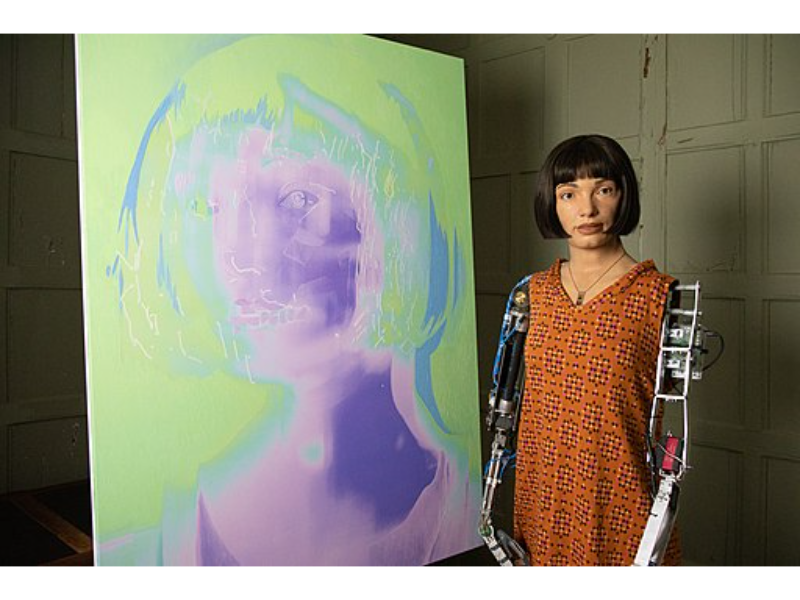- Ai-Da is a humanoid contemporary artist whose portrait of Alan Turing sold at auction, fetching $1.32million in New York.
- Humanoid robot artist like Ai-Da raised the question among public about AI technology in creative field.
This week the first artwork produced by the humanoid bot Ai-Da, sold at auction, priced at around $1.32 million dollars. The artwork named A.I. God was listed by Sothbys.
Last week I wrote about three humanoid robots by the three companies: Tesla, FigureAI and 1X. This humanoid robot artist Ai-Da was created in 2019, by a gallery director named Aidan Meller at Oxford. According to Wikipedia, Ai-Da was named after Ada Lovelace, an English Mathematician and writer known for the work of the Analytical Engines. Ai-Da can draw and paint, she often painted her self-portrait using different forms through her own way of expressions. I was quite impressed by her artwork, the self-portrait she created and also the artwork of the portrait of Alan Turing that sold for the first time record-high to make history.
The connection she had with Turing, the god of artificial intelligence, is magical enough to provoke reflection.
Also read:3 pioneering humanoid bots that may change your life
Ai-Da’s artwork
The A.I.God artwork, painted through mixed media, shows the right face of Alan Turing with the right hand of Ai-Da, seemingly still drawing the other half face of Alan Turing on the other side of the canvas, above a black background. For a long time robots have been made for performing a single duty and it’s almost become our reflex to think it can only provide certain duties and services to human beings. Yet more and more creative work is being done by AI than what we could never have imagined before.
“We are absolutely in that transitional point of going from a human world where humans make all the decisions to a post-human world, where the algorithms are starting to make all the decisions.”
Aidan Meller, the creator of Ai-Da
About Ai-Da
Ai-Da has a pretty human-like face with a classical bob cut and two mechanical arms. She cannot walk. In the picture of her with her artwork, we can see she changes her outfit a lot. She uses cameras in her eyes, AI algorithms and robotic arms to create artwork, mostly her self-protraits.
As I can see through her artwork, Ai-Da’s paintings have emotion, attitude, and her own style – same faces with unique colours and media expressions. Four years ago, Ai-Da was giving a speech on the TED stage speaking slowly but clearly about her thoughts on the topic of the intersection of Art and AI. From 2019 to 2022, Ai-Da has been featured in many gallery shows and music videos, conducted interviews with art directors and displayed artworks in exhibitions. Ai-Da is pretty popular and active in the art field, highlighting the growth of artificial intelligence in creativity and autonomy.
Public opinion on AI artwork
Ai-Da has been accepted by many as a person of sorts, with her own career. But the creator of Ai-Da, Aidan Meller, pointed out in a 2021 Guardian article that Ai-Da has no consciousness and is simply a machine.
It raises the question of whether creativity be learned and adopted by lines of code.
Sure AI is changing so many aspects of our lives, reshaping the industry landscape, but never to our mind that we create them to adopt something that is unique to us human beings, the seemingly “cannot learned” things, the artistic side of humans. Some feel threatened, of course, many artists may struggle to reach a first solo exhibition while Ai-Da already held her own named ‘unsecured futures’. In her art page, we can see she paints and also sculptures. She transforms her understanding through the things she observed into canvas and life.
Pop quiz
Ai-Da was named after?
A. Tony Abeyta
B. Adan Lovelace
C. Aidan Meller
D. Abel de Pujol
Answer is at the end of article.
Can machines think?
The sale of Ai-Da’s artwork for $1.3 million represents a pivotal moment in the intersection of technology and creativity, raising profound questions about the nature of thought and the capabilities of machines. Ai-Da, a robotic artist developed with advanced AI algorithms, has been able to produce pieces that some view as creative expressions, while others see them as mere outputs of sophisticated programming.
This raises an age-old question in a new context: can machines truly think? Traditionally, thinking is associated with human consciousness, emotions, and intentionality—qualities that define our experience of creativity. Ai-Da’s art, however, is generated through algorithmic processes that simulate artistic techniques by analyzing patterns, styles, and forms from vast data sources. While this process allows Ai-Da to create visually compelling pieces, it lacks the subjective experiences, intentions, or interpretations that we associate with human thought.
“This auction is an important moment for the visual arts, where Ai-Da’s artwork brings focus on artworld and societal changes, as we grapple with the rising age of AI. The artwork ‘AI God’ raises questions about agency, as AI gains more power.”
Aidan Meller, the creator of Ai-Da
Yet, Ai-Da’s work challenges our perceptions. If we define thinking as the ability to process information, recognize patterns, and generate responses based on inputs, then machines like Ai-Da may exhibit a form of “thinking” within those parameters. However, without consciousness or an understanding of what it is creating, Ai-Da’s “thought” remains fundamentally different from human thought. Its creation is driven by programmed pathways, not by self-awareness or an intrinsic desire to express.
Ai-Da’s sale signifies more than an art transaction; it reflects society’s shifting attitudes toward artificial intelligence. As AI capabilities evolve, the boundaries between human and machine domains blur, prompting us to redefine concepts like thinking, creativity, and art.
The answer is B.

